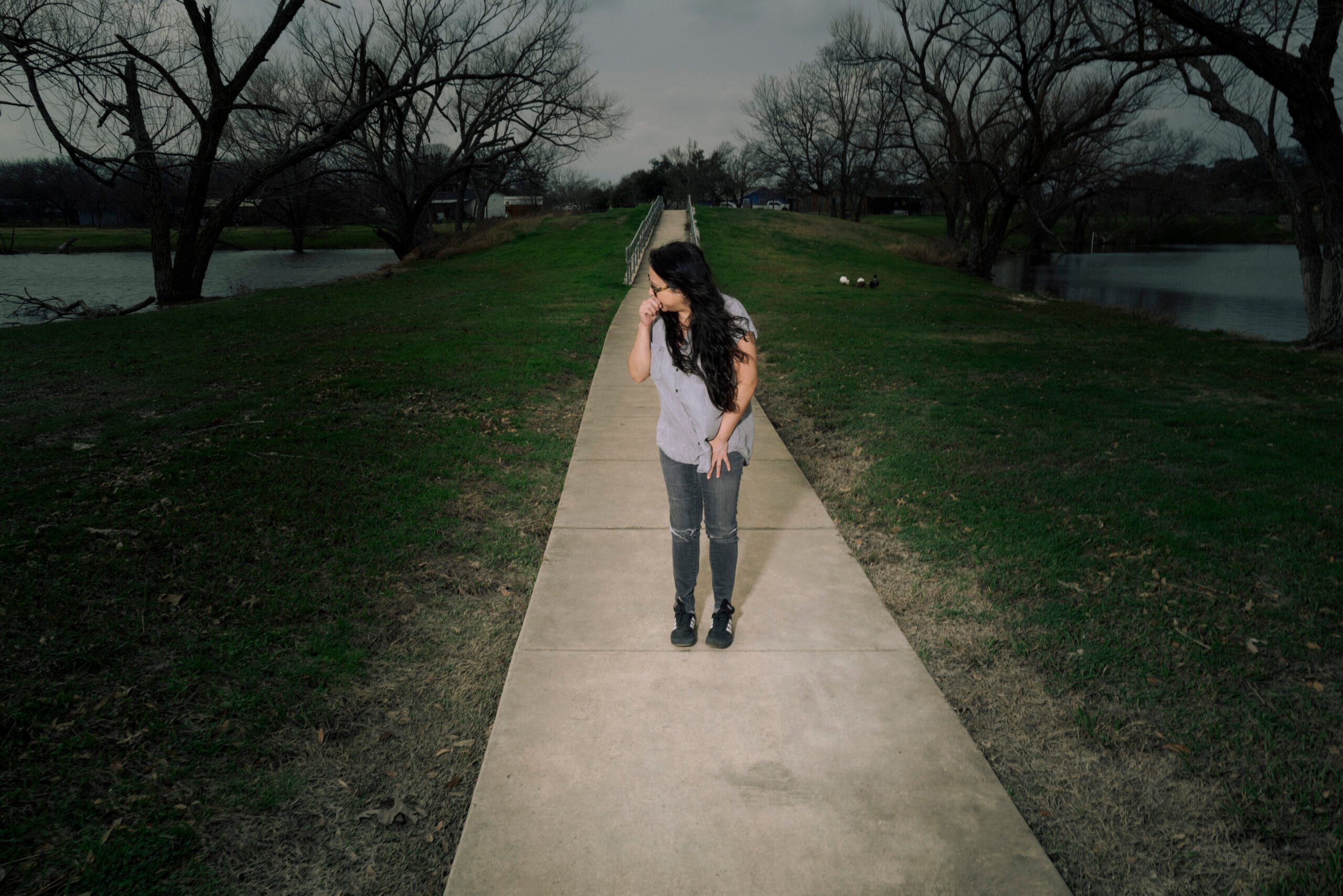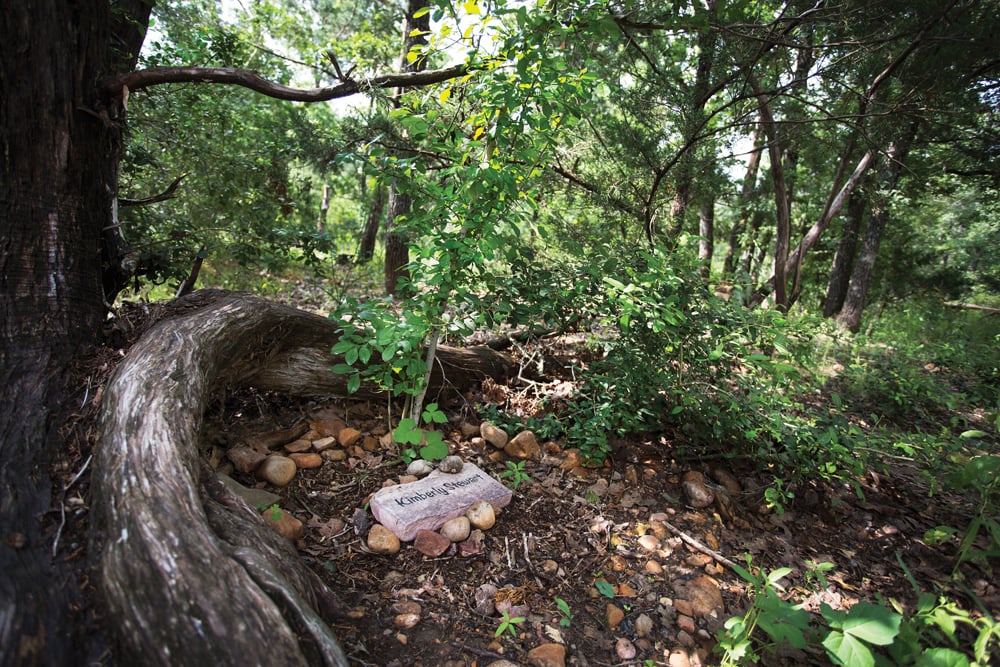
At Rest in the Fields
Celebrating childhood's end at Eloise Woods.
A version of this story ran in the June 2015 issue.
Above: A simple memorial stone serves as the only visible marker for this shaded gravesite.
There is nothing unusual about these three girls. They are sisters. They have eyes and ears and they will remember this part of their lives forever. Taylor Ann, 9, is the oldest, and determined to speak for the others, even when it gets her in trouble. She is a smiley redhead with freckles and talks without punctuation or taking breath.
Tori is the second-oldest at 7. She is exactingly articulate, pronouncing each syllable in “e-ver-y-thing.” She has light brown hair and a slight lisp, evidence that she is growing as she speaks, her baby teeth falling out and her adult teeth growing in. Her voice is perfectly childish and curious.
Texie, 4, is the baby sister, but not the youngest sibling. That title goes to the girls’ 2-year-old brother, Junior. Texie’s placement on the second-to-bottom sibling rung sets her just high enough to grab her older sisters’ attention, but she is still something of a baby when it comes to conversation. Even so, her sporadic observations are often quite sharp. Of the three girls, Texie has the most recognizable voice when they’re all talking at once. It’s a soft garble she uses in hiccup-like bursts to coo to her stuffed animal or scream “Caaaoooolllerr the feaddderrrs!” at the ruffled bird in her coloring book. She has baby-blue eyes and platinum-blond hair, and she makes her sisters laugh.
The sound of the three of them speaking at once is not unusual. Tori and Taylor Ann bicker over the details of a story about a kitten while Texie boks like a chicken. When I ask about their oldest brother, L.J., Taylor Ann quickly gives an answer she thinks will satisfy me, and then goes back to talking about her cat. “No,” I say, clarifying my question. “How long were you with him at your house after he actually died?”
Every time they visit Eloise Woods, the natural-burial park where their brother is buried and where I work, they reveal a new angle of their experience of his death. Today’s angle is that they don’t feel like talking about it.
“Oh, you mean like right after he died?” The other two are quiet now. “Um, just a night. Yeah, just one night.” The distinction is meaningful because, as Taylor Ann had told me earlier, the sisters were with L.J. for a whole year after they knew he was going to die. I look at the younger girls and they’re not interested in talking about it. We’ve talked about it enough over the last three months. Every time they visit Eloise Woods, the natural-burial park where their brother is buried and where I work, they reveal a new angle of their experience of his death. Today’s angle is that they don’t feel like talking about it.
“Let’s go see L.J.,” Tori says.
“Yeah!” the other girls shriek.
We leave the coloring books on the small table between the two sheds where we always meet and walk down Cardinal Trail to visit his grave.
I was wearing hiking boots and jeans with a bloodstain on one of the belt loops when I caught the eye of the lady at the gas station.
“Going to the beach?” she asked coyly.
“No,” I said, giggling. “A cemetery.”
“Ooooooh,” she gasped, her interest piqued.
I didn’t have time to get flirty about death. I swiped my card and rushed back to my car. Just broaching the subject of what I do often turns into a lengthy discussion about the complicated politics and emotions surrounding natural burial. It’s imperative that I engage in these discussions, and most of the time I do. Word of mouth is one of the few ways people learn that they can in fact bury people in Texas without embalming, without a vault, without even a casket. They can even bury on their own land if they meet the requirements of their county and aren ’t concerned with complicating resale of the property. But such conversations are rarely brief, and I had to get to the Woods.
We weren’t sure what time the family would be arriving with L.J., the 11-year-old who had died the night before. Specifics weren’t part of the deal with his family. Though we’d known for close to a year that they would have a home funeral followed by a natural burial, we knew little else. Even the boy’s condition—why he was terminal—was discussed only vaguely by the family. All we knew was that he was in a wheelchair and that he didn’t have long to live.
Home funerals usually lead to natural burials, but not always. Most of our families employ conventional funeral homes, hold a service in a chapel and transport the body to us in the funeral home’s vehicle. We have good relationships with many funeral homes in Austin, even though we can tell their employees feel out of place when their shiny loafers step onto our roads, mulched to prevent erosion. They usually give us a couple of days’ notice before they arrive. The night L.J. died, Ellen MacDonald, my boss, the owner of Eloise Woods, emailed me at 1 a.m. telling me to show up the next morning at 8.
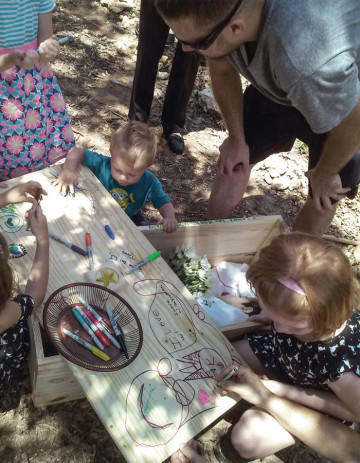
Every time I drive to Eloise Woods, the sun strobes on my left cheek as it passes between houses and trees. It’s a bright nuisance, just beyond the reach of my visor. I drive along Austin’s eastern edge, and once I’m past the airport and under the toll road, it’s a straight shot to the burial park. I listen to music at a loud volume, usually a certain Warren Zevon live album. I roll down my windows and daydream the rest of the way to the cemetery.
When I park at the Woods 25 minutes later, I remember that I’ve forgotten my hat and will be feeling the full heat of a June day. I complain about it to Ellen as I walk from my car. “I hardly slept last night,” she responds. “I just figured I’d get out here as early as I could to get it set up. The grave still needs to be deeper because I guess they’re bringing him in a casket now.” Under Texas law, a bare body, or one in a permeable encasement such as a shroud, must be buried at least 24 inches deep. An impermeable case, such as a casket, must be covered by at least 18 inches of earth. The first few feet of topsoil is where the most aggressive organic activity takes place, turning whatever has been buried into plant food. We had dug 2.5 feet deep, enough that L.J. in a shroud would be covered with 24 inches of soil. But a family member had offered to build a casket at the last minute, and now we needed to dig at least another foot to ensure that a full 18 inches of soil would cover his little box.
It’s about 50-50 at the Woods when it comes to shrouds vs. caskets. Only one person has been buried without any covering at all—an infant from a Hindu family. Cremation is a custom in that religion, a manner of releasing and purifying the soul, but children are considered already enlightened, and so natural burial with nothing between the body and the earth is traditional. Ellen told me she had laid rose petals on the soil before the baby was placed in the grave, a gesture in line with why someone had offered to construct a casket for L.J. Burying a child in raw dirt isn’t easy.
Ellen wore an apron with a picture of a cat wearing a chef’s hat and the words “The Chef Breathlessly Awaits Your Order” printed beneath.
“I thought it was cute, you know? Kids like cats. Something kind of fun for today,” she explained. Ellen is good at remembering what’s most important and forgetting everything else. Today was all about being there for the kids.
Ellen had no connection to funerals or burials when she bought the Eloise Woods property in 2009. She had completed a doctorate in neuroscience at Stanford University before becoming a stay-at-home mom in Austin. She was so inspired by the show Six Feet Under, where she first learned about natural burial, that she decided to get into the death business herself. She became obsessed with creating a space in Austin where people can bury their dead themselves, a place where the memory of the deceased can continue to grow with the landscape.
Ellen is the reason I got into natural burial. Her accomplishments as an industry outsider signified a shift in my profession and revealed an opportunity largely untouched by traditional industry professionals. In Wisconsin, where I received my funeral director’s license, combining the business of funeral homes and cemeteries is prohibited under the state’s anti-combination law. Due to this 80-year-old statute, I became accustomed to hearing each business condemn the other, usually over outrageously high prices.
When I got to Texas, which allows the two businesses to be combined, it became apparent that such criticisms stemmed from a shared anxiety about the future of the industry as a whole. Cheap, efficient cremations have risen in popularity since the ’90s, eating into the conventional funeral industry’s profits. Families with little interest in embalming or holding a service make it harder for funeral homes to maintain their value.
Even Houston-headquartered Service Corporation International, the nation’s largest funeral corporation, appears to be acknowledging this change of venue. In October 2014, having lost a battle to overturn Wisconsin’s anti-combo law, Service Corporation opted to sell the last of its 16 Wisconsin funeral homes, keeping the five cemeteries it owns in the state. For people in search of a final resting place for their ashes or bones, a cemetery is the only choice. Natural burial parks that are accustomed to working with families without the involvement of a funeral home make that choice easier.
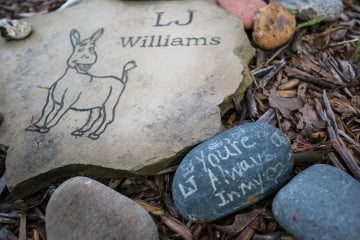
The first burial I worked at Eloise Woods was for a young man in his late 20s. This last summer we buried three kids: one boy of grade-school age and two infants. There are more than 60 occupied plots in the park, a quarter of them for infants and children.
I met L.J.’s family for the first time about a month prior to his death. His three sisters attacked me with questions and whirled with an exuberance that only children seem able to bring to their first experience of death. Having never seen me or even heard my name, they grabbed my hands and Texie crawled into my arms as we set off to explore the graves.
“What happens if you are the last person on earth and everyone else dies?” Tori asked.
“I guess it would be very quiet,” I answered.
“Do you know the month and day you are going to die?” she asked. I said I did not.
“When you die, are you the same age forever?” Taylor Ann asked.
I thought about that carefully before saying “I think so,” though I also told them I was unsure. Then I asked what age they would want to be forever, and we all agreed we’d want to be somewhere in the teenage years, in the bloom of youth.
They picked the wild coreopsis that grows along the paths to put near L.J.’s gravesite. As we came upon the nearby grave of a 26-year-old man, his pensive portrait engraved on his stone, they wondered how he had died. I didn’t know, and that’s what I told them.
“My brother is going to die and come to Eloise Woods,” one of the girls said. At L.J.’s grave, their parents stood with a stroller into which was strapped their littlest brother. Jackie, their mother, looked only slightly overwhelmed and remarkably well put together. She was talking to Ellen about why she’d brought the girls. They’d been confused about L.J.’s future whereabouts, so Jackie thought it would be good for them to see the little 3-by-3-foot hole with the pile of dirt next to it. They laid rocks around the hole, and flowers inside of it.
The girls were fascinated by the wildlife of the park. It looks like a wooded campground, full of bugs, lizards and animals. Hoping to see a bunny, we walked a few more trails while they told me that L.J. slept a lot and no longer got in his wheelchair.
One of them asked me what happens when you die.
“Out here,” I said, pointing to some wildflowers, “you become a plant.”
“What!?” they yelped in confusion.
“Plants are going to grow out of his body?” Tori asked. I realized that I’d have to explain decomposition to complete the puzzle.
“Well, after we die, our bodies break down,” I stammered. I tried again: “They sort of fall apart.” It was no use. Looks of confusion and then boredom crossed their faces.
“Let’s go look for Mom,” said Taylor Ann. They took off, away from me.
They found their parents at the sheds and Ellen presented them with markers and rocks to scribble messages on for L.J. Tori wrote “Get Well Soon” on one. Texie drew a fairly sophisticated cat on another.
The more they colored, the more evident it became that L.J.’s death was an event they were preparing for in much the same way they would prepare for a birthday. To add extra excitement, the date would be a surprise, no matter how ready they thought they were.
Ellens cat apron was overshadowed by other sartorial matters once L.J.’s family arrived for his burial. Taylor Ann jumped out of the van barefoot and ran over to me. She had been too distracted to put on shoes before they’d left their house that morning. After parking the van, Jackie opened the door with a mixture of confusion and exhaustion on her face. She caught sight of the bare feet and became annoyed. “Where are your shoes? I told you to put on shoes!” she yelled.
Taylor Ann’s face suddenly reflected the gravity of the day, a collision of sadness and anger at having been yelled at by her mother, who had just lost a child. She burst into tears. Ellen quickly offered some extra sneakers she kept in the shed. Tori and Texie hopped out of the van wearing matching handmade black dresses with white cats on them and pink-and-blue cowboy boots. Taylor Ann stomped down Cardinal Trail toward L.J.’s grave wearing the same cat-pattern dress and borrowed sneakers five sizes too big.
The small group of guests held armfuls of sunflowers and babies. Kids ran wild while their parents alternated between quiet grief and chirping baby talk. The back door of the van remained open and unattended under a bright early-afternoon sun. Inside was a simple pine box about 4 feet long.
It’s hard to explain how it felt to watch the girls embrace their dead brother in his casket. How they kissed his face and stroked his hair then delightedly shoveled dirt onto his grave.
Jason, L.J.’s stepfather, and another man got inside the grave with shovels provided by Ellen and finished the digging that we’d been unable to complete that morning. The sisters posed with their sunflowers while I took pictures on my phone, and then they colored pictures to place inside the casket with L.J. After about half an hour, Jackie and Jason went to the van for the casket. Jackie’s face carried a look of powerful intention as they brought it to the grave and set it on the path while we all gathered around. They opened the top and laid it perpendicular across the casket, revealing little L.J. lying on his side, wrapped in a white blanket.
Everyone took turns writing on the top of the casket. The girls laid their pictures next to L.J.
A pastor wearing a rainbow sash covered in peace signs and yin-yang symbols started the ceremony. Taylor Ann, not quite grasping the mood, interrupted with an enthusiastic observation and was reprimanded loudly by Jackie. Still stinging from her earlier scolding, Taylor Ann began to pout until the pastor asked her to stand next to her. Together, they began to read a children’s poem that attempted to explain death.
The girls’ 2-year-old brother, Junior, out of his stroller for the first time I had ever seen, began to stalk the woods. While everyone stood sweating and patient, listening to the poem, Junior squatted outside the circle and began to taste the dirt. Jason alternated between chasing him and standing near Jackie, his expression lightening and darkening between the two situations. When the service was over, everyone said their goodbyes before placing L.J.’s casket into the earth.
It’s hard to explain how it felt to watch the girls embrace their dead brother in his casket. How they kissed his face and stroked his hair then delightedly shoveled dirt onto his grave. If I had to try, I would say it was like hearing a child’s first attempt to pronounce a new word. Ever afterward you hear that word differently, spoken without apprehension and full of love.
The next time I saw them I was measuring and marking plots in an open field. The girls came running at me with arms spread wide like I was someone they loved. I was ripe from working in the sun all day, but Texie clung to me like she had the first day we met. We talked about the other kids who were buried there and walked to one of their graves. Jackie asked questions about him. All the parents do this. They want the story on the kids, looking for similarities that will pull them together. I didn’t know much about the kid’s story, so I asked about L.J.’s.
At the sheds, I gave the girls the coloring books I had brought that day. Junior, red-faced and awake, rolled in the dirt. Jackie gave me the long version of L.J. ’s situation, which started with his being diagnosed with spina bifida, which isn’t a life-threatening condition. The events that led to his death began with him toppling over in his wheelchair. The accident apparently created fissures in his skull, through which cerebrospinal fluid drained. Jackie says his doctors misdiagnosed L.J.’s resulting condition for years before she finally convinced them to perform a 12-hour surgery, but it was too late to save him. He didn’t have to die, she said. She showed me pictures on her phone: L.J. with purple, puffy eyes and a zig-zag incision across the top of his skull. Then she showed me pictures of L.J. when he was healthy, with big brown eyes and a shy smile.
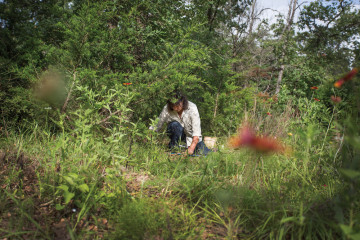
They don’t have the energy to file a lawsuit, but they are angry. The constant hospital visits put a huge strain on the family. They were briefly homeless, sleeping in a van in the hospital parking lot.
“That was my favorite because I got to lie down,” Taylor Ann said, smiling and drawing out “liiiiie doooown” and spreading her arms. Jackie gave her an odd smile, unsure if it was safe to laugh at her daughter’s black humor in front of me. I told Taylor Ann that what she’d said was oddly comical, and Jackie broke into a relieved smile. She said that when L.J. died, the family finally had a laugh. Home funerals, like parenting, bring unpredictable joys.
Jackie explained that after L.J. died, as they were washing him, they had pulled out his gastrostomy tube, creating a leak. They scrambled for the Krazy Glue to close the hole. They all laughed as Jackie recounted this, and the girls became giddy as they clamored to offer their favorite silly moments of the death. They told me about how L.J.’s body went floppy after he died and the girls played with his limbs like a doll. Texie had waved his hand, mimicking a lecturing adult. “I’m Dr. George, and you’re not sick,” she mimicked. The sisters burst into giggles again. I could see very clearly how deeply they loved one another, how making their mother smile and laugh was the most important thing in their world.
Jackie, flushed from the laughter, said L.J. would pull at her hair to bring her closer, right until the end. She said the girls all slept with him in the living room the night after his death. Texie told us that now he’s in Eloise Woods in a silly voice that her sisters made her repeat over and over while they laughed.
When I left that day, I cried all the way home.

